
|
|
January 25, 2006: Features
Rising stars
Profiles by Jessica Dheere ’93, Katherine Hobson ’94, Tiernan Ray ’92, and Anne Ruderman ’01
You may not recognize the names of the dozen alumni on the following pages — but chances are that one day, you will. They are a small sampling of the many alumni receiving critical and popular acknowledgement for their work: both young graduates just a few years out of college, and more established artists who are creating indelible marks in their fields. Some discovered their creative instincts at Princeton; others used their time on campus to nurture talents that took root at a young age. Together, they illustrate the presence of Princeton in every corner of the arts world.
When Hobart Earle ’83 became conductor of the Odessa Philharmonic Orchestra in 1991, he took over an orchestra in which woodwind players had post-concert headaches from trumpets blasting into their ears, some instruments were more suitable for a well-funded high school orchestra, and heavy curtains made for an acoustical nightmare. Usually, the orchestra performed in half-empty concert halls.
In 14 years, Earle has overseen the orchestra’s fairy-tale rise into a globe-trotting phenomenon that performs with top musicians to sellout crowds and takes home classical music awards. He has done it through a combination of management acumen and musicianship, pairing a difficult international repertoire with pieces by contemporary Ukrainian composers.
But most of all, Earle, the first non-European conductor to lead an orchestra in the former Soviet Union, has earned the trust of a Ukrainian port-city with a long-standing musical tradition and a formidable sense of artistic pride. “European groups will accept an American conductor, if they come with a pedigree,” says Michael Pratt, conductor of the Princeton University Orchestra, who taught Earle 20 years ago. “But for a young unknown American conductor to be accepted and embraced by an orchestra is completely different.”
Born to an American businessman and a choral conductor in Venezuela, Earle “grew up with music all around me,” singing the boy’s soprano role in Mozart’s The Magic Flute and studying piano and clarinet. At Princeton, Earle majored in music and began to understand “the psychological side of music and the thinking side,” in addition to the emotional aspect. After graduation Earle took off for the Academy of Music in Vienna and then made his way to Odessa, accepting the conducting job at the age of 30 for a salary of $50 per month.
Earle is both discursive and brilliant, with an impeccable memory and a penchant for ruminating on anything, musical or not. Musicians who play for him describe his style as open and encouraging — a dialogue rather than a dictum. “When he opens his hands to the orchestra his gesticulations are very inviting, and when he rehearses with his orchestra, he speaks really directly out of his heart,” says Dietmar Kueblboeck, a trombonist who has been a soloist with the Odessa Philharmonic. “He tries to make the orchestra members as enthusiastic as he is himself.”
On the northern tip of the Black Sea, the city of Odessa, with 1.1 million people, has a powerful musical tradition. Founded in 1937, the Odessa Philharmonic was the recipient of a steady flow of well-trained talent, but in the Soviet scheme of things, only two orchestras really mattered: Moscow and St. Petersburg. By the late 1980s, the Odessa orchestra had fallen on hard times.
Attendance was down, equipment was worn, and a cold draft blew into Philharmonic Hall on winter nights. Most of the musicians had never played outside the country. There was no government support for touring or instruments, and the orchestra had a limited repertoire.
When Earle arrived, he had one main objective: to inspire. “My first priority was to do whatever I could to motivate two groups of individuals at the same time — the musicians and the audience.” He proved himself to be a managerial mastermind and adept fund-raiser, became fluent in Russian, and endeared himself to the orchestra.
The audience enjoyed new music; under Earle, the orchestra played Austrian giants Gustav Mahler and Anton Bruckner for the first time, as well as American Aaron Copland and British composers Gustav Holst and Edward Elgar — broadening the orchestra’s range of Western music far beyond Beethoven and Brahms. Meanwhile, he devoted the orchestra to Ukrainian compositions, such as Kiev composer Reinhold Glière’s rendition of “Taras Bulba” by Nikolai Gogol. Above all, he took the orchestra on the road to famed auditoriums, like the Musikverein in Vienna and the Philharmonie in Cologne, and less-famous ones, like Richardson Auditorium at Princeton.
Earle is the first to say the work isn’t over. The orchestra doesn’t own its own concert hall, meaning that the Odessa Philharmonic must compete for theater time with fashion shows, wine tastings, and rock concerts. But the days of the provincial orchestra fighting the acoustic-defying stage curtains and playing before half-empty halls are long gone.
“There are a lot of conductors out there who could stand in front of [a great orchestra like] the Berlin Philharmonic and it would sound great no matter who they are,” Pratt says. “He built this from the ground up.”
By A.R.
Bonus material online:
A
longer profile of Hobart Earle ’83 is available online, click here.
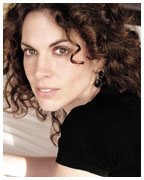 Ruth
Gerson ’92, singer and songwriter
Ruth
Gerson ’92, singer and songwriter
(Photo by Lisa-Marie Mazzucco)
In a packed, sweaty living room in Chicago’s Lincoln Square, Ruth Gerson ’92 tunes up her acoustic guitar for 60 strangers. People spill out into the hallway; they sit cross-legged on the floor and on laps on the couch. “We feel like family now!” Gerson says to the audience, cracking the ice. She pulls out a notebook, settles on a messy page of scratchings, and tries a new song: White houses clean in rows/Stone fences of lovers/Sleeping still behind curtains/With windows closed.
For 75 minutes Gerson roams the landscape of justice, ethics and love, her favorite topics. Or, as she wryly puts it: “Why we shouldn’t pummel those who are smaller and weaker than us.”
Gerson’s soaring vocals and her warmth and humor pull the audience in closer, making a small space even more intimate. A riveting performer who spent years playing rock clubs and touring Europe (Italians voted her “best singer” in a 1999 poll), Gerson has been compared to Bruce Springsteen, Bob Dylan, and Joni Mitchell by well-known critics. Last February, a lengthy article in The New York Times raised the question: Why isn’t she famous?
The answer: By reviving the small gatherings of ’60s and ’70s folk artists, Gerson is pursuing success on her own terms. Among other shows this year, Gerson will play about 50 “living-room concerts,” an alternative to the club scene. The home-based concerts not only offer a deep personal connection to her audience, they provide a greater financial reward. She has introduced the concept to hundreds of people and encouraged other artists to perform in private homes.
Gerson started playing piano at age 3 and writing songs “as soon as I could talk,” she says. A native New Yorker, she studied drama at the city’s celebrated High School of Performing Arts and spent summers during her Princeton years at the British-American Drama Academy at Oxford. At Princeton, she moved from drama to music and became immersed in the study of ethics. A religion major, she was profoundly affected by religion professor Robert Gibbs, who taught a course on Jewish existentialism. “To this day, I go back to those books for inspiration,” she says.
She started playing in rock clubs soon after graduation, garnered glowing reviews, and signed with Epic Records in 1994. But after about 18 months, she asked to leave the record company so she could find her own musical direction. Her first homemade cassette sold 500 copies in two weeks.
In 1998, Gerson wrote to Bob Dylan’s publisher to request permission to record a song, and Dylan agreed to meet her. The two sat in a Manhattan office and played songs together on their guitars. Dylan “was very much like a professor, extremely kind, understanding,” Gerson says. He picked up one of her CDs and read the reviews. Then he cautioned her: “Be careful, don’t let people call you a songwriter. You’re a song performer. You don’t write them so they sit there; you write them to sing to somebody.” Dylan also suggested that Gerson dig into the roots of songwriting, and she found new influences such as American folk songs of the Dust Bowl era.
The living-room concerts started with a fan’s offhand remark a year later, at a time when Gerson was playing rock clubs and touring Europe. After she performed at a packed but financially disappointing gig in Washington, D.C., in 1999, a fan asked Gerson when she would next be in town. “Well, I’ll come play in your living room, but I’m not playing that club again,” Gerson replied.
The fan took her seriously, inviting 60 friends to her home. After donations and sales of CDs that night, Gerson made $1,200 — far more than she could make at a club — and envisioned a life with greater independence and flexibility. “It’s do-it-yourself, but a fun and and viable option to sustain yourself as an artist,” she says. It has paid off: Gerson has sold 40,000 copies of her five self-produced albums and has raised more than $60,000 for charities over the last year or so.
This year, Gerson, a mother of two, will release three new albums, including two to be distributed by Fontana/ Universal. She hopes the wider distribution will expand her audience and let her explore artistically at a sophisticated level; she also will play clubs in major cities when she can. But she plans to maintain her living-room base. “I became so enamored with doing [the concerts] that they took over my life,” she says.
By T. R.
Bonus material online:
A longer profile of Ruth
Gerson ’92 is online, click here to read.
Lately, when he’s not teaching at Princeton or Columbia College in Chicago, Accra Shepp ’84 is in North Carolina, Kentucky, or Georgia, taking pictures of tobacco farmers, their crops, and their farmhands. He is documenting life on the farm, to “let people know that they work really hard,” he says. But Shepp, through his images, also wants to look at tobacco’s “emotional baggage,” to understand why our culture continues to support smoking even as it demonizes it.
The work is “not an antismoking piece, not a pro-smoking piece,” says Shepp, who, using a process he developed while a senior Fulbright fellow in Indonesia, will print the photographs on tobacco leaves themselves. He sees the contradictions of tobacco as another means to explore his “fascination with how we mediate our own existence in this world.”
Shepp, a Brooklyn native, came to Princeton “to be an engineer.” But at the end of his sophomore year, at the last possible moment, a passion for photography ignited in junior high school and nurtured ever since, led him to major in art history and visual arts. He went on to get a master’s degree in art history, specializing in paper conservation, at New York University’s Institute of Fine Arts. “I went to the Met every day,” he says, “maybe only for 15 minutes, but every day.” But after realizing he could name only one conservator who also made art, he chose once again between photography and science. And once again, photography won.
Still, science and even engineering play a significant, if subtle, role in Shepp’s work, which will be included in the show “Artificial Afrika” at New York’s Gigantic Artspace in January. One of his latest series of prints splices together interior stairways and platforms of elevated-train stations, among other industrial landscapes.
By J.D.
Bonus material online:
To view Shepp's images,
click here.
 Noah
Haidle ’01, playwright
Noah
Haidle ’01, playwright
(Photo by Christopher Dawson ’94)
It’s hard not to marvel at how New York City playwright Noah Haidle ’01 sprang out of the block: He scored an agent after his first graduate school reading at Juilliard, while another play, Mr. Marmalade, was produced by California’s South Coast Repertory while he was a student. Now, just months after his Juilliard graduation, that show is running (through Jan. 29) at New York’s Roundabout Theater.
Haidle has been a student of the genre since he was a teenager, when he bought a collection of interviews with playwrights at a secondhand sale. It captivated him; he’d never met an artist, let alone a playwright, and was suddenly aware that it was a possible career. He put himself on a regimen of reading as many plays as possible. “I wanted to be part of this great tradition where a kid in Grand Rapids can find your play in a book,” he says.
At Princeton he majored in English so that he could do a creative thesis, writing a play with Michael Cadden as his adviser, and was editor of the Nassau Weekly. He went to graduate school at Juilliard to focus on writing. “It gave me permission to take myself seriously,” he says. “I said, ‘This is my job now.’” In addition to Mr. Marmalade, which is about a precocious 4-year-old and her imaginary friend, Haidle has had three other plays produced, including A Long History of Neglect, which was developed at Princeton and premiered at McCarter’s Berlind Theatre in the fall, with a student cast.
His work tends to be comic — even in more serious plays, “everything comes out a little bit funny,” he says. When a play is in production, he writes every day. He reads more plays than he sees (favorite playwrights are Samuel Beckett, Christopher Durang, and Martin McDonough) and prefers not to read reviews, paraphrasing Gabriel Garcia Marquez’s line that “I don’t want to learn anything about myself that I don’t already know.” Instead, he loves watching a show in previews, when he still has a hand in it and can tinker according to the audience’s response. “Learning about a room, how it reacts — that’s your education,” he says.
By K.H.
 The
Klez Dispensers, musicians
The
Klez Dispensers, musicians
Photo: The Klez Dispensers, standing, from left, Ed Browne *03 and Inna Barmash ’01, both former members; and Alex Kontorovich ’02, Audrey Wright, Amy Zakar ’99, and Adrian Banner *02. Kneeling, from left, Ben Holmes ’01 and Gregg Mervine. (Lloyd Wolf)
Klezmer music is eclectic; it’s rooted in traditional Yiddish instrumental celebration music, but in the United States it has also been influenced by jazz and other homegrown genres. The same could be said of the Klez Dispensers, a group founded at Princeton in 1998. Its roster includes an international mix of former Princeton undergrads (Amy Zakar ’99, Ben Holmes ’01, Alex Kontorovich ’02), grad students (Adrian Banner *02), and staffers (Audrey Betsy Wright, a research librarian at Firestone) with strong backgrounds in classical and jazz music.
The group’s founders were playing together in the Princeton University Jazz Ensemble when they first heard klezmer. The style was enjoying a revival in the 1990s, and klezmer bands were springing up on college campuses everywhere.
“It was almost as if we said, ‘Hey, all these people are doing klezmer — let’s see what it is,’” says Banner, a classically trained pianist.
Early rehearsals consisted of listening to recordings and trying to play the music by ear. Slowly, band members began to develop their own style, revisiting traditional songs and writing original pieces influenced by gypsy and Latin jazz music, and bringing in a vocalist who is well known in the klezmer world. “We gravitated toward klezmer that’s less folksy and more jazzy,” says Banner.
Today the band members live along the Philadelphia–Princeton–New York corridor; some are full-time musicians, while some, like Banner, a mathematician, have other jobs. The band released its second CD, the highly regarded New Jersey Freylekhs, in 2004 (recording for a third begins next month), and performs at private celebrations, clubs, theaters, klezmer festivals, and Princeton’s own Communiversity: “Our main fan base is still in Princeton,” says Banner, “and we don’t forget that.”
By K.H.
Bonus material online:
Listen to the to Klez Dispensers—click
here.
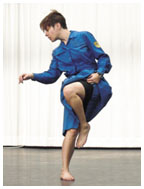 Jill
Sigman ’89 *98, choreographer
Jill
Sigman ’89 *98, choreographer
(Improvisation at Florida State University; Photo by R. McCullough)
H Dance can be many things: a pirouette, a two-step, a slide, a lunge. But dialing a phone number and receiving instructions from an answering machine at the other end? Well, says Jill Sigman ’89 *98, a dancer and choreographer who founded the Manhattan-based jillsigman/thinkdance, that is for the viewer to decide.
“Viewers can become really passive and see watching work as being a consumer,” says Sigman about why she often asks audience members to engage in games as a part of her performances. When viewers phoned the answering machine, for example, they received instructions about how to look around the environment while viewing the performance. “I want my viewers to take an active role in the relationship,” Sigman says. “I want the work to make people think.” The same goes for her dancers. “It was interesting to see how she married her political awareness with the concerns of the craft of making dance,” says Ursula Eagly ’99, a dancer and former student of Sigman’s. Eagly recalls a performance meant to send a message about women’s issues, in which five dancers in formal wear put on lipstick at the same time: “I remember rehearsing, drawing on ourselves with lipstick for hours; it was important to [Sigman to see] how the movement looked, and how the lipstick looked on our bodies, the picture that it left behind.”
Sigman, who majored in philosophy and then returned to Princeton to pursue her Ph.D., founded her company in 1998. She had grown weary of splitting her time between the study of philosophy and the practice of modern dance, which she had begun (after years of training in classical ballet) during her first semester at Princeton. “I got tired of feeling like my feet were on two different icebergs floating apart,” she explains. Since then, she has taught and given dozens of performances in the Unted States and Europe in unusual venues — such as an old gym and an abandoned printing house — of her multimedia works, which, owing to their interactive nature, leave a lot to chance.
Sigman recently was awarded a fellowship at the Maggie Allesee National Center for Choreography at Florida State University, where she spent October teaching and conducting choreographic research for her developing work /RUPTURE/, which “explores connections between the human body, the architectural ‘built’ world, and the political/global structures we live in.”
By J.D.
Bonus material online:
Additional images of
Jill Sigman—click here.
Most people listening to a Top 40 radio station hear complete, if not always palatable, songs. Composer Nick Brooke *03 hears something else. To create his piece “You Feel This,” he snipped individual words from those songs — “you,” “feel,” and “this,” as the title suggests — and rearranged them into something entirely new, a pop-song sum that’s nothing like its parts.
While that kind of sampling plays a large part in his work, it’s only the beginning. Brooke also experiments with instruments — he composes for everything from his computer to gamelan, a kind of Indonesian orchestra that includes gongs, chimes, and drums, and he has built his own instruments. Tone Test, the opera from which “You Feel This” came, was performed at the Lincoln Center Festival in 2004. Brooke calls it a chamber opera, and it features performers lip-synching and interacting with old and new recordings in what one reviewer called “an aural collage.” It was inspired by Thomas Edison’s attempts to sell the nation on his diamond disk phonographs by conducting head-to-head, on-stage comparisons of a live singer and a phonograph recording of her voice.
Brooke has been a serious student of classical music since childhood. After graduating from Oberlin in 1991, he spent two years in Indonesia studying gamelan and working with artists there. At Princeton he earned a Ph.D. in music composition, and he now teaches music at Bennington College.
His work always has a large visual element, something he feels traditional concert performances lack. Lately he’s focusing on the performance aspect rather than recordings; his current project, Mass, will be in the same vein as Tone Test. It’s not as easy to listen to as a pop song — as Brooke says, “a lot of people don’t listen to my music because you can’t cook an omelet to it.” But the varied reactions it provokes make his point: Music is an emotional force that has different effects on different people. At one performance, one person was laughing while another was in tears, he says, adding, “That’s how it should be.”
By K.H.
Bonus material online:
Listen to his work—click
here.
(Photo courtesy Jeff Kreisler ’95)
Jeff Kreisler ’95 began his stand-up career at an unlikely event: a Princeton student production of Flowers for Algernon, a drama not known for its knee-slappers. But technical problems stopped the show, so Kreisler, a cast member, took the stage to amuse the audience. People laughed, and Kreisler got his first taste of the rush of being what he calls a court jester: “You get to talk about the important things but as long as you’re a little goofy, you can speak the truth.” In Kreisler’s case the important things include political and social topics, like trickle-down economics, that don’t usually make it into the stand-up scene.
He’s long been fascinated by the power of words to shape the world; at Princeton he was a politics major and wrote his thesis on the democratization of the Russian media. On a hiatus from law school, he experimented further with stand-up, then moved to San Francisco and studied in earnest after graduating. He supported himself doing freelance writing and legal work, but his main focus was on performing. “The only way you learn and progress is by doing,” he says, “often in front of audiences that vary quite wildly in temperament.”
Kreisler has tapped into one market niche, though: progressive campus and community groups receptive to “Comedy Against Evil,” the lineup of comics he has organized whose acts feature a lot of railing against the current presidential administration. He says that’s partly a matter of opportunity — “If the Democrats were in power I’d be skewering them” — and partly because his own politics are progressive. When he’s performing at more traditional venues, he says, he tones it down a bit.
Still, he doesn’t shy away from sensitive issues. One of his best experiences came when he traveled to West Virginia to do a show for a conservative audience. “Afterwards I had two hours of conversation with people about religion,” he says. Not only did it help him refine his act, he says, there was a real dialogue going on among people with opposing viewpoints, something that rarely happens in today’s polarized political arena. “Comedy,” he says, “can be a way to open communication.”
By K.H.
Bonus material online:
Listen to six minutes
of Jeff's stand-up comedy—click here.
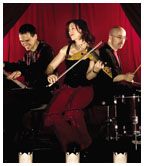 Valerie
Vigoda ’87, songwriter and musician
Valerie
Vigoda ’87, songwriter and musician
(Photo by Jon Spaihts ’91)
Valerie Vigoda ’87 and her band, GrooveLily, “beat their heads against the wall” for more than a decade trying to get a record deal. They played 150 shows a year, had loyal fans, and got great reviews, but record executives didn’t know what to do with them. “We were trying to be more pop; we were trying to be more consistent,” she says. Finally the band members made a decision: “Let’s do what we are naturally.” In their case, that meant building on the theatrical bent to their songwriting.
From those modest intentions sprang Striking 12, a musical the band calls a “rewired” version of Hans Christian Andersen’s “Little Match Girl.” Vigoda was touring as an electric violinist with the Trans-Siberian Orchestra — which performs huge productions combining elements from a rock band, symphony, and choir — and was amazed by the enthusiastic, cross-generational response to the show. She recognized a niche. GrooveLily’s idea, developed with Tony Award-winner Rachel Sheinkin, was to rework Andersen’s depressing tale as an “uplifting, fun, and joyful evening,” she says. Vigoda and fellow band members Gene Lewin ’84 (drums and vocals) and Brendan Milburn (keyboards and vocals), Vigoda’s husband, play themselves and other characters in the show.
In their inaugural run at Philadelphia’s Prince Music Theater, they discovered an additional benefit of theater. “We were in one place for four weeks — we only had to set up the drums once,” she says. The band has performed the piece over the last few holiday seasons and is planning to take it to Broadway in 2006. GrooveLily has a lot more on its plate, including a new take on A Midsummer Night’s Dream that features a larger cast and will play at McCarter Theatre this spring.
But GrooveLily is still very much a band, playing dates and giving fans a regular stream of new singles. “We said we were going to go with what we did best,” Vigoda says, “and the universe started to respond, as it does when you do what you love.”
By K.H.
Bonus material online:
Click here for several
Groovelily extras.
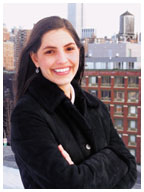 Debra
Singer ’89, arts curator and director
Debra
Singer ’89, arts curator and director
(Photo by Cody Trepte)
For more than 30 years, New York City’s most risk-taking multimedia artists, composers, and performers — think Laurie Anderson and Philip Glass — have found a place of their own at the Kitchen. And since last year, after an eight-year stint at the Whitney Museum of American Art, Debra Singer ’89 has also called the nonprofit, interdisciplinary art space home.
Since assuming her role as the Kitchen’s executive director and chief curator, Singer has focused her attention on recommitting the Chelsea venue to its original mission: providing a place for experimental artists to make new work. So far this has included converting one of the space’s two black-box theaters into exhibition space, “so that the Kitchen becomes a destination for the daytime as much as the evening,” and partnering with literary and cultural magazines such as Fence and Cabinet so that they have a place to host events that require audio- visual capabilities, she explains.
“We are all about production; we are not a collecting institution,” says Singer. That is one reason why, she says, “a large percentage of Kitchen audiences are artists themselves.”
She sees her role, finely honed while co-curating the 2004 Whitney Biennial, a major event in American contemporary art, as “curator-cum-business manager.” It’s different handling the works of living artists versus those of dead ones, says Singer, who participated in theater at Princeton and later worked for the Woolly Mammoth Theatre Company in Washington, D.C., before getting a master’s degree in African art history.
“I have to listen closely to artists and what their vision is. I have to be an enabler and a naysayer, particularly in a museum environment because there are so many things that you can’t do.”
At the Kitchen, however, it doesn’t seem that there are many things Singer can’t do. A recent $10 performance by the European group Superamas incorporated actors lip-synching the lines of Hollywood movies on a set dressed to look like an upscale tiki bar, when, without warning, the house went dark, the stage emptied, and the soundtrack of the opening sequence of Saving Private Ryan began to play while strobe lights mimicked machine-gun fire. For those few moments, play-acting generated real fear.
By J.D.
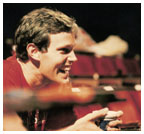 Davis
McCallum ’97, director
Davis
McCallum ’97, director
(Photo by Cara Reichel ’96)
Princeton wasn’t always Davis McCallum ’97’s first choice. Between his freshman and sophomore years on campus, McCallum, who had been involved in theater throughout his high school years in Atlanta, decided that since he wanted to be an actor, he should be at Julliard. He auditioned — but didn’t get in.
So McCallum returned to Princeton. Now, after co-teaching a class with playwright Chuck Mee this fall and directing A Long History of Neglect, a recent play by Noah Haidle ’01 that opened in November at McCarter’s Berlind Theatre, one might conclude that he never left.
“If I had gone to a bigger theater school, I might not have had the opportunities I did at Princeton,” says McCallum, who started the Princeton Shakespeare Company while a student and began teaching in the Program in Theater and Dance five years ago, after earning a master’s degree while a Rhodes Scholar at Oxford (to add to his Pyne Prize at Princeton).
It was in England that McCallum let go of his actor’s dream and began to develop his director’s instinct instead. “Acting would get frustrating,” he says, “because you can only influence one small part of the canvas.”
But as he read more and more plays, he began to find himself “thinking about the style of the play and what kind of a space it would take place in and what the story was.”
Making such observations is one thing, but it’s another entirely to translate them to the rehearsal room — a place in which McCallum says he loves to be because it “forces me to get with other people and engage.” Still, he seems to have an instinct for that, too. “I see his manner with people,” says Mee, whose play Big Love McCallum directed at Princeton in 2003: “He gets everybody on board having a good time and doing their best.”
By J.D.
(Alexander Williams)
“Right after the invasion of Iraq, I was reading the paper and listening to the news compulsively,” recalls Philadelphia artist Melissa Ho ’92. “Like most of us, I was desiring information but feeling completely dissatisfied. I needed a physical activity to help me work through that and cancel it out.”
So in the summer of 2003 Ho began to reconsider a main source of that anxiety, the “Nation at War” section of The New York Times, and embarked on a process of what she calls “healing the page.” She would first select spreads from the section; then, leaving the images intact, she would paste over the text with blocks of colored paper and lush floral cutouts from seed catalogs and garden magazines. Her goal, she says, was to use the color and the “images being unmoored from their captions” — in one case, for example, daffodil paragraphs “describe” several Iraqi men forced to kneel in a ditch — to trigger altogether different sensations than one would get from reading the words.
The arresting juxtapositions earned Ho, who was an art history and visual arts major at Princeton and now teaches painting at Temple University, a 2005 Pew Fellowship in the Arts. The award, which gives Philadelphia-area artists at a critical juncture in their careers the financial means to focus exclusively on their work, comes with a no-strings-attached $50,000 prize. Ho, who always had funded her creative pursuits with paycheck-producing ones, is using the award to find out what it feels like to be an artist only.
She’s quick to acknowledge, however, that even some of her past administrative work — she was an exhibition assistant on the 2002 retrospective of painter Barnett Newman at the Philadelphia Museum of Art — influences her time in the studio. “After spending all that time with Barnett Newman,” says Ho about her approach to the collages, “I wanted to emulate him, to try to do as much as possible with as little as possible.”
By J.D.
Bonus material online:
To view Ho's work, click
here.
![]()

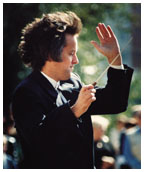 Hobart
Earle ’83, conductor
Hobart
Earle ’83, conductor
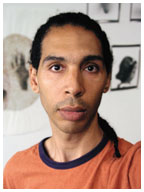 Accra
Shepp ’84, photographer
Accra
Shepp ’84, photographer 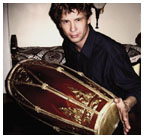 Nick
Brooke *03, composer
Nick
Brooke *03, composer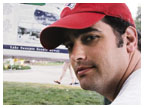 Jeff
Kreisler ’95, comedian
Jeff
Kreisler ’95, comedian
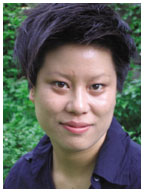 Melissa
Ho ’92, visual artist
Melissa
Ho ’92, visual artist